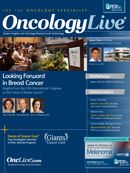On the Genomic Horizon: Analyzing Polymorphisms May Predict Adverse Events
Two teams of investigators report that analysis of germline polymorphisms yields valuable clues about which patients may experience adverse events from anticancer therapies.
Maurie Markman, MD
Editor-in-Chief of OncologyLive
Senior vice president for Clinical Affairs and National Director for Medical Oncology Cancer Treatment Centers of America, Eastern Regional Medical Center
It has long been recognized that genetically defined factors can influence the potential toxicities experienced by patients receiving cytotoxic antineoplastic therapy.1,2 Unfortunately, the general clinical applicability of an examination of normal genetic polymorphisms for their impact on the adverse events of individual patients has been quite limited. This state of affairs is likely due to a number of factors, including the time, effort, and cost of such examinations and the historical observation that only a small percentage of patients potentially appeared to benefit from the knowledge gained through genetic testing.
However, the unquestionable revolution in the technology of genomic analysis has resulted in a profound reduction in the cost of such evaluations and the ability to substantially expand knowledge of the role of germline polymorphisms in defining clinical outcomes in the oncology arena.3
Consider, for example, two recent reports in the peerreviewed oncology literature of the relationship between host genetic features and the risk of highly relevant treatment-associated adverse events.4,5
Investigators at the University of California, Los Angeles, prospectively assessed the development of fatigue and other behavioral disturbances in a group of 171 women with breast cancer who underwent an analysis for the presence of genetic polymorphisms involving three genes previously revealed to be associated with a “proinflammatory” state.4 The investigators then developed a genetic risk score based on the specific pattern of expression of those polymorphisms. Of considerable interest, the research revealed an association between both the number of high-expression alleles in two single nucleotide polymorphisms and the combined genetic risk index with the severity of self-reported fatigue, as well as a correlation between the index and symptoms of depression and difficulties with memory.
While the results of this provocative study require confirmation, the data provide supportive evidence for the relevance of an inflammatory component in the development of these specific clinically relevant treatment-induced symptoms. Further, and of even greater importance, they suggest a potential role for taking measures to prevent or ameliorate these toxicities in particular individuals at a genetically defined high risk for the adverse events.
In the second report, investigators at the St. Jude Children’s Research Hospital examined the relationship between certain genetic polymorphisms known or believed to be associated with antineoplastic drug metabolism, pharmacokinetics/ pharmacodynamics, oxidative stress, and interference with noncancer-related neurocognitive function, with the outcomes of 243 patients previously treated for childhood acute lymphoblastic leukemia.5 It is relevant to note here that the antineoplastic regimen employed in this patient population included risk-adapted chemotherapy without prophylactic cranial radiation.
The overall patient group was shown to experience problems with “attention” compared with national norms (P = .01) when tested two years after the completion of anticancer therapy.5 Further, while the authors noted that the risk of behavioral abnormalities was clearly multifactorial (including, importantly, the intensity of the therapeutic regimen), the analysis suggested that the presence of specific polymorphisms related to drug metabolism, oxidative stress (eg, glutathione S-transferases), and the inherent ability to repair central nervous system damage might substantially impact that risk, with varying degrees of statistical significance for particular polymorphisms.
Again, while the results of this study will need to be confirmed in one or more independent patient groups, the data suggest that knowledge of germline polymorphisms may potentially influence the specific choice of therapy or result in the introduction of prophylactic efforts to reduce the risk of these difficult adverse events from curative therapy in childhood leukemia.
The data presented in these two interesting papers clearly represent the mere beginning of a future intense exploration of the relationship between a wide variety of normal genetic polymorphisms and the risk that an individual patient will experience a clinically relevant toxicity from antineoplastic therapy.
References
- Coate L, Cuffe S, Horgan A, et al. Germline genetic variation, cancer outcome, and pharmacogenetics [published online ahead of print August 2, 2010]. J Clin Oncol. 2010;28(26):4029-4037.
- Wang L, McLeod HL, Weinshilboum RM. Genomics and drug response. N Engl J Med. 2011; 364(12):1144-1153.
- MacConaill LE. Existing and emerging technologies for tumor genomic profiling [published online ahead of print April 15, 2013]. J Clin Oncol. 2013;31(15):1815-1824.
- Bower JE, Ganz PA, Irwin MR, et al. Cytokine genetic variations and fatigue among patients with breast cancer [published online ahead of print March 25, 2013]. J Clin Oncol. 2013;31(13):1656-1661.
- Krull KR, Bhojwani D, Conklin HM, et al. Genetic mediators of neurocognitive outcomes in survivors of childhood acute lymphoblastic leukemia [published online ahead of print May 6, 2013]. J Clin Oncol. 2013;31(17):2182-2188.




